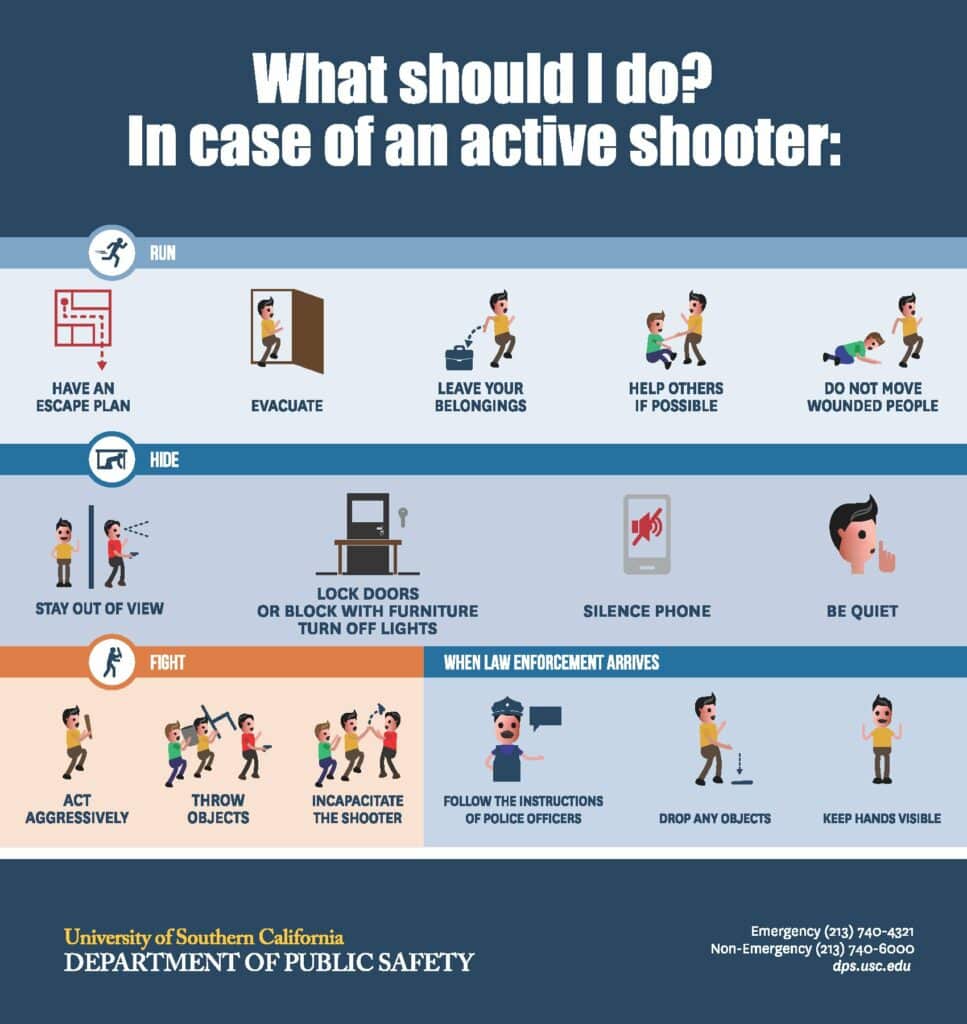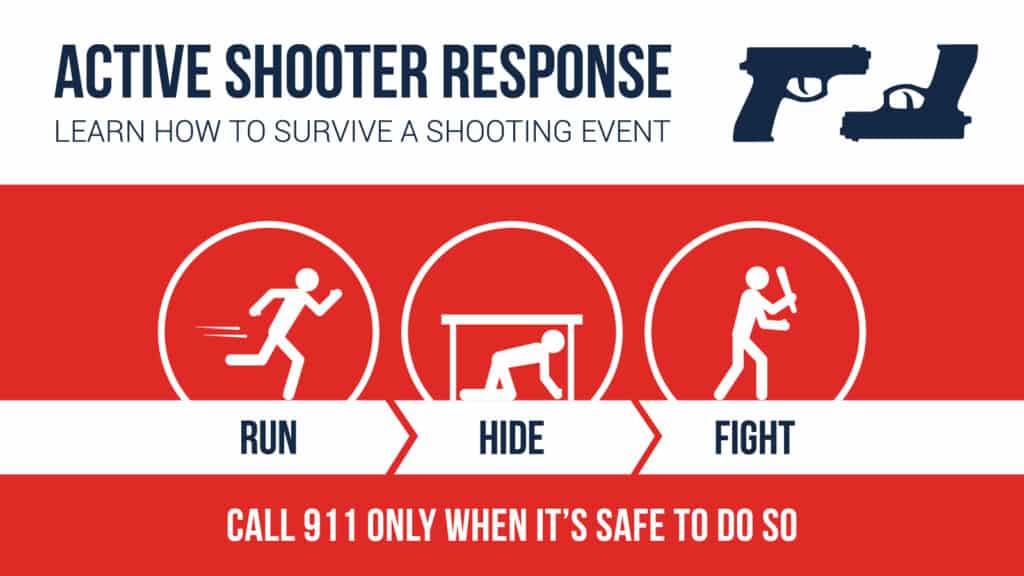Active shooter incidents have become an unfortunate reality in recent years, leaving communities devastated and raising questions about safety in public spaces.
The Run Hide Fight! Active Shooter Response strategy has emerged as a widely endorsed method to increase the chances of survival during these unimaginable events.
Let’s dive into the details of this strategy, examine its effectiveness, and explore alternative approaches to prepare for and respond to active shooter situations.
On This Page:
Key Takeaways
- Run, Hide, Fight is a three-step strategy endorsed by the Department of Homeland Security to increase survival chances in active shooter situations.
- Organizations should have response plans, and individuals must be aware of statistics and trends for better preparation.
- Alternative strategies such as MOVE!, Identify, Assess & Prevent and Training Intuition & Instincts offer additional options for responding to active shooter scenarios.
What is the Run, Hide, Fight Strategy?

The Run, Hide, Fight strategy is a three-step process designed to increase the probability of survival during active shooter situations. Endorsed by the Department of Homeland Security, this approach is straightforward, easily retained, and applicable to a wide range of scenarios.
It involves three main steps: running away from the threat if possible, hiding if escape is not feasible, and fighting back as a last resort.
It is important to note that the Run, Hide, Fight strategy does not consider the psychological and emotional repercussions of an active shooter event. However, its simplicity and ease of recall make it an essential tool for individuals caught in the terrifying grip of an active shooter incident.
RUN: Evacuate Safely
The first step in the Run, Hide, Fight strategy is to evacuate if a safe path exists, especially if the shooter is nearby.
Once in a safe location, call 911 and provide information about the situation to aid those still in the building. Your immediate actions can save lives.
HIDE: Seek Shelter
If evacuation is not feasible during an active shooter situation, the second step is to find a secure hiding spot that is difficult for the shooter to access. When selecting a hiding spot, try to find a bulletproof area that can be locked or barricaded to prevent intruders from entering.
In addition to finding a secure place to hide, it is imperative to:
- Move out of sight as quickly as possible
- Silence mobile devices
- Maintain absolute silence until authorities have declared the area safe
- Barricade doors to prevent access by the attacker
FIGHT: Take Action as a Last Resort
As a last resort, the Run, Hide, Fight strategy suggests utilizing any available objects to attempt to disarm or impede the shooter, with an emphasis on personal safety. If escape and hiding are not possible, individuals must be prepared to take action to protect themselves and others from harm.
In these desperate moments, using items in the vicinity as weapons and projectiles can disorient and impede the shooter, potentially preventing them from continuing to kill people. Remember, your personal safety should always be the primary concern, and taking action is a last resort when all other options have been exhausted.
Preparing for an Active Shooter Situation
Over 80% of active shooter events occur at a public or private workplace, highlighting the need for organizations to have response plans in place.
The “Active Shooter: What You Can Do” Online Training Program, provided by FEMA and DHS, offers valuable information on responding to active shooter incidents.
Preparing for an active shooter situation is an essential aspect of ensuring your safety and the safety of those around you. In this section, we will discuss the importance of:
- Developing an active shooter response plan
- Mapping escape routes
- Conducting training and drills to familiarize yourself and others with the procedures in case of an active shooter incident.
Developing an active shooter response plan is important to ensure that everyone in the building knows what they are doing.
Developing an Active Shooter Response Plan

An active shooter response plan should include prevention, response, and recovery measures to manage such incidents effectively. Creating or updating a plan for shared workspaces is a critical component of preparedness, encompassing evacuation plans, shelter-in-place plans, and maintaining the continuity of operations.
Once a response plan is developed, contact local law enforcement agencies for any queries regarding these materials or any other matters related to active shooter incidents. Cooperation between law enforcement, fire, and EMS agencies is crucial for a successful response plan.
Mapping Escape Routes
Mapping escape routes and identifying safe hiding spots within a confined and populated area, such as a building or facility, can significantly affect your ability to respond to an active shooter incident. Rapidly analyzing the circumstances and deciding upon the swiftest and most secure means of escape is essential.
Posting maps in common areas that mark stairwells, egress doors, and areas of refuge can provide a quick reference to the most accessible exit during an active shooter incident. Remember, knowing your surroundings and having a clear escape route can save lives.
Conducting Training and Drills
Regular training and drills can ensure that all parties involved are familiar with the active shooter response plan and procedures. Effective drills should provide opportunities for students and staff to understand their roles and responsibilities before, during, and after an active shooter situation involving an individual actively engaged as one of the active shooters.
Training should also equip individuals to:
- Respond with confidence
- Provide guidance on the “Run, Hide, Fight” protocol
- Engage in frequent practice
- Heighten situational awareness
- Cultivate their instincts
- Learn to rely on their intuition in high-pressure situations.
Law Enforcement’s Role in Active Shooter Incidents

The primary role of law enforcement in active shooter incidents is to terminate the shooting and reduce potential harm to victims. Their immediate response is to neutralize the threat and safeguard potential victims. Law enforcement is also essential in rescuing injured persons, providing medical assistance, and preserving the crime scene.
Before law enforcement arrives, individuals should take appropriate measures to ensure their safety and the safety of others. This can include fleeing from the perpetrator, finding a secure place to hide, and, as a last resort, engaging the perpetrator.
Evaluating the Effectiveness of Run, Hide, Fight
Let’s evaluate the effectiveness of the Run, Hide, Fight strategy by discussing its strengths and weaknesses. We will also explore how it compares to other active shooter response methods.
Strengths
The simplicity and memorability of the Run, Hide, Fight framework make it applicable in various situations. The strategy emphasizes the necessity of:
- Having an exit strategy
- Prioritizing security
- Furnishing instructions on concealing oneself
- Fighting back as a last resort.
The Run, Hide, Fight strategy is easily retrievable, making it an essential tool for individuals caught in active shooter incidents.
Weaknesses
Critics argue that the Run, Hide, Fight strategy fails to address the “freeze” response, which can cause people to be paralyzed and unable to make decisions in stressful situations. They also contend that the strategy is founded on linear thinking and may foster a victim mentality.
Moreover, some opponents believe that the Run, Hide, Fight strategy does not effectively equip potential victims to protect themselves and others during an attack, as it oversimplifies intricate and highly stressful situations into a catchy phrase.
MOVE! Escape or Attack – An Alternative Strategy
The Move! Escape or Attack active shooter response strategy encourages individuals to take appropriate action in accordance with their own judgment, whether that is to flee or to respond with force. This approach empowers individuals to make decisions based on their intuition and instincts, rather than following a rigid three-step process.
Trusting one’s instincts is essential in enabling the swift decision-making process in hazardous circumstances. By practicing and refining their intuition and instincts, individuals can make more informed decisions and increase their chances of survival during active shooter scenarios.
Summary

The Run, Hide, Fight strategy is a straightforward and memorable framework that provides individuals with a response method during active shooter incidents. While it has its strengths, critics argue that it may not effectively equip potential victims to protect themselves and others in all situations.
Alternative methods, such as MOVE! Escape or Attack, offers more flexible approaches that empower individuals to take action based on their instincts and judgment.
Ultimately, being prepared, aware, and adaptable can make all the difference in surviving an active shooter scenario.



